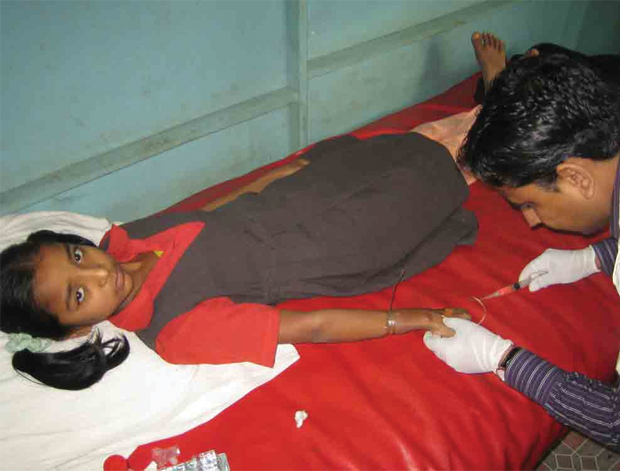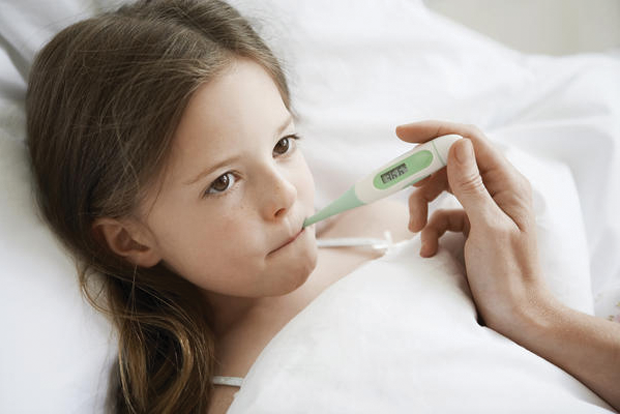|
What is typhoid fever?
Typhoid fever is an acute illness associated with fever caused by the
Salmonella typhi bacteria. It can also be caused by Salmonella paratyphi,
a related bacterium that usually causes a less severe illness. The
bacteria are deposited in water or food by a human carrier and are then
spread to other people in the area.
The incidence of typhoid fever in the United States has markedly
decreased since the early 1900s, when tens of thousands of cases were
reported in the U.S. Today, less than 400 cases are reported annually in
the United States, mostly in people who have recently traveled to Mexico
and South America. This improvement is the result of better
environmental sanitation. India, Pakistan, and Egypt are also known as
high-risk areas for developing this disease. Worldwide, typhoid fever
affects more than 21 million people annually, with about 200,000 people
dying from the disease.
|
|
 |
|
How Do People Get Typhoid Fever?
Typhoid fever is contracted by drinking or eating the bacteria in
contaminated food or water. People with acute illness can contaminate
the surrounding water supply through stool, which contains a high
concentration of the bacteria. Contamination of the water supply can, in
turn, taint the food supply. The bacteria can survive for weeks in water
or dried sewage.
About 3%-5% of people become carriers of the bacteria after the acute
illness. Others suffer a very mild illness that goes unrecognized. These
people may become long-term carriers of the bacteria -- even though they
have no symptoms -- and be the source of new outbreaks of typhoid fever
for many years.
How Is Typhoid Fever Diagnosed?
After the ingestion of contaminated food or water, the Salmonella
bacteria invade the small intestine and enter the bloodstream
temporarily. The bacteria are carried by white blood cells in the liver,
spleen, and bone marrow, where they multiply and reenter the
bloodstream. People develop symptoms, including fever, at this point.
Bacteria invade the gallbladder, biliary system, and the lymphatic
tissue of the bowel. Here, they multiply in high numbers. The bacteria
pass into the intestinal tract and can be identified in stool samples.
If a test result isn't clear, blood samples will be taken to make a
diagnosis.
|
|

|
|
hat Are the Symptoms of Typhoid Fever?
The incubation period is usually 1-2 weeks, and the duration of the
illness is about 3-4 weeks. Symptoms include:
Poor appetite
Headaches
Generalized aches and pains
Fever as high as 104 degrees Farenheit
Lethargy
Diarrhea
Chest congestion develops in many people, and abdominal pain and
discomfort are common. The fever becomes constant. Improvement occurs in
the third and fourth week in those without complications. About 10% of
people have recurrent symptoms after feeling better for one to two
weeks. Relapses are actually more common in individuals treated with
antibiotics.
How Is Typhoid Fever Treated?
Typhoid fever is treated with antibiotics which kill the Salmonella
bacteria. Prior to the use of antibiotics, the fatality rate was 20%.
Death occurred from overwhelming infection, pneumonia, intestinal
bleeding, or intestinal perforation. With antibiotics and supportive
care, mortality has been reduced to 1%-2%. With appropriate antibiotic
therapy, there is usually improvement within one to two days and
recovery within seven to 10 days.
|
|

|
|
Several antibiotics are effective for the treatment of typhoid fever.
Chloramphenicol was the original drug of choice for many years. Because
of rare serious side effects, chloramphenicol has been replaced by other
effective antibiotics. The choice of antibiotics is guided by
identifying the geographic region where the infection was contracted
(certain strains from South America show a significant resistance to
some antibiotics.) If relapses occur, patients are retreated with
antibiotics.
Those who become chronically ill (about 3%-5% of those infected), can be
treated with prolonged antibiotics. Often, removal of the gallbladder,
the site of chronic infection, will provide a cure.
For those traveling to high-risk areas, vaccines are now available.
Typhoid Fever At A Glance
Typhoid fever is caused by Salmonellae typhi bacteria.
Typhoid fever is contracted by the ingestion of contaminated food or
water.
Diagnosis of typhoid fever is made when the Salmonella bacteria are
detected with a stool culture.
Typhoid fever is treated with antibiotics.
Typhoid fever symptoms are poor appetite, headaches, generalized aches
and pains, fever, and lethargy.
Approximately 3%-5% of patients become carriers of the bacteria after
the acute illness. |